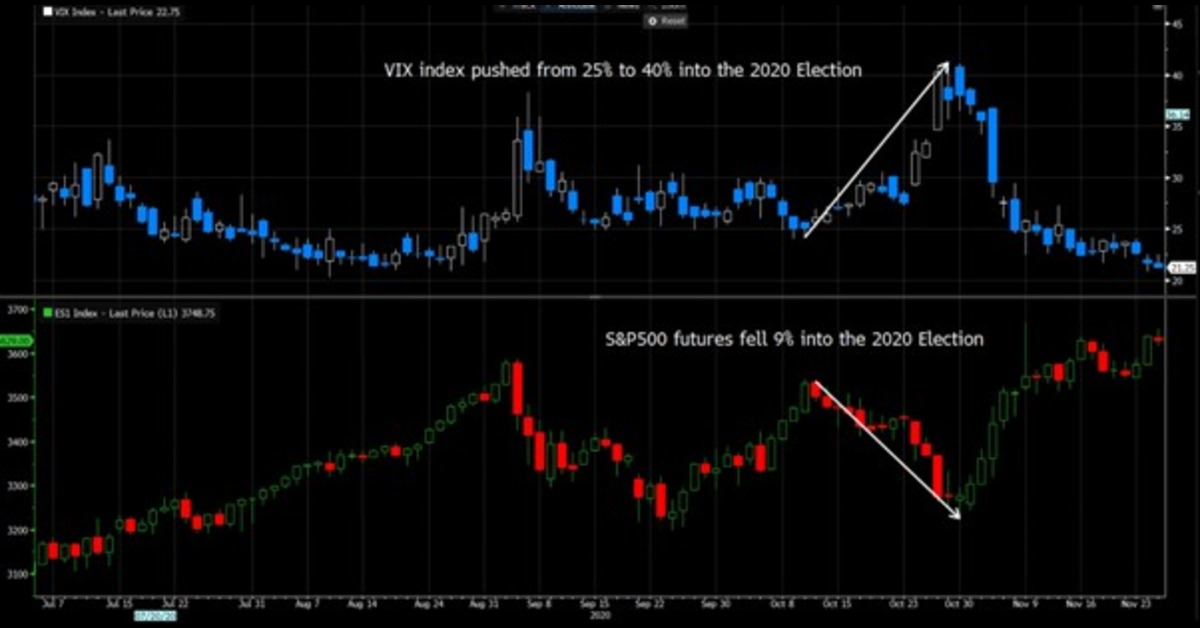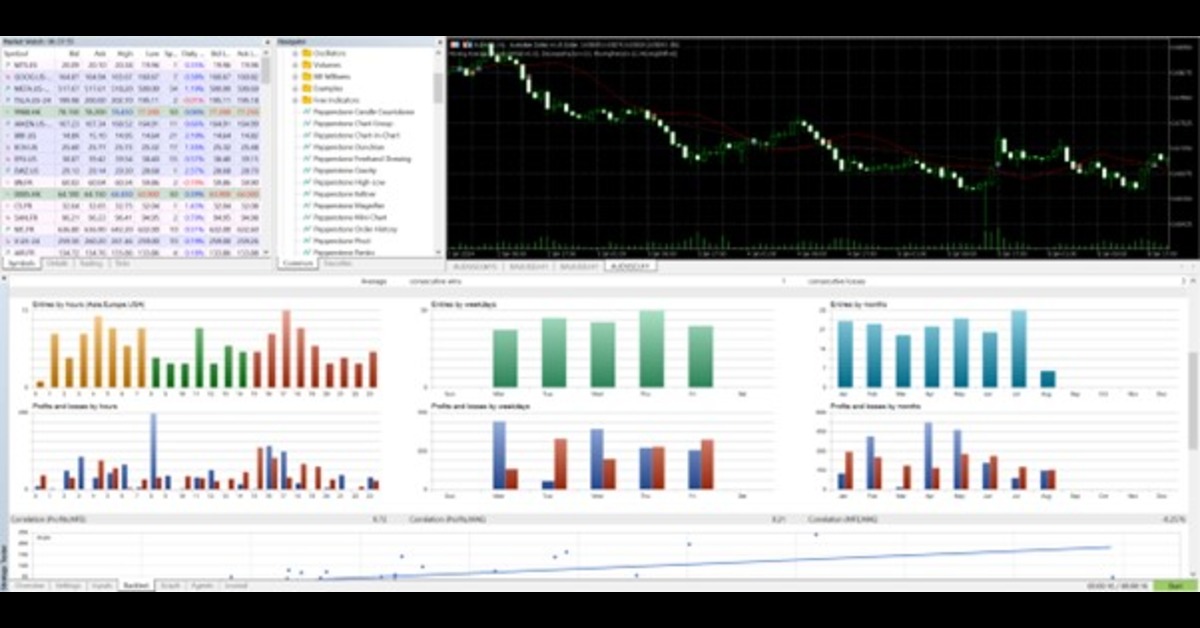Analysis
What Automated and EA Traders Need to Consider When Trading the 2024 US Election

We obviously don’t know what those conditions will look like, but it’s fair to assume that the closer we get to the election we could see reduced liquidity in markets, expansion in the daily high-low trading ranges and increased broad market volatility.
Moves in the VIX index & S&P500 futures into the 2020 US Election

There is no one-size-fits-all guide as to how automated trading systems/EA’s (Expert Advisor) operate through the fluctuations in price, volatility and trends into the election – that is determined by the objectives of the trading system, the strategy the trading system is executing, the timeframe it typically operates in, and the market(s) it trades.
Regardless of the considerations, robust backtesting involves testing a strategy over the longest data set possible - the greater the sample size, the increased diversity and variance in the underlying market conditions the test captures.
Some will say that because the US election occurs so infrequently the sample size of US elections within a data set isn’t statistically significant. In turn, the US election is an outlier event that invalidates the backtest when evaluating the performance of the trading system/EA through the election cycle.
I would look at it differently.
Given the role of technical and price action analysis is to find repeatable patterns and behaviours and to execute when we see high probability outcomes and set-ups - if we have a diverse enough range of market cycles, trends and volatility regimes captured in our backtest, essentially, we should see the US election as just another period within a data set.
Automated trading is about reaction not prophesising
In theory, automated/EA traders shouldn’t care about or be influenced by the underlying cause of market movement but focus fully on how the system performs in the underlying market and trading environment. If prior elections have resulted in extreme volatility and violent reversals, choppy price action or trending conditions (high or lower), the system (EA) should account for that and only execute trades that have an edge in whatever the underlying conditions are at that time.
Liquidity and volatility impact the environment in which we operate
Automated traders should also be aware that as we get closer to the US election it will not just be the volatility in markets that can change, but also the liquidity in the order book may evolve too, and this can see changes in an instrument's bid-offer spread, and result in a higher cost to trade.
Reduced liquidity in markets may then result in exacerbated moves, where large orders can be more impactful on the price action.
Be dynamic to volatility
Many of the more sophisticated automated trading systems have rules that are dynamic to the volatility in price and the underlying movement in the market at that time. This is prudent and recommended, as the risk we take in a position (i.e. the distance to the stop loss) should align with the volatility in the market, with the position size dictated by the additional risk taken.

For example, if the 2-day ATR (Average True Range) is more than 1.5x its 20-day ATR, then this may see the system look to enter a new position with a wider stop loss (from entry). Subsequently, the position size taken would be reduced from what it may typically be in a lower volatility regime – that is if the system is to take trades in this environment at all.
Automation removes emotion and reacts to the collective wisdom of the market
Another factor that is core to most automated strategies is the complete removal of news as an input. While discretionary traders will likely be influenced by the emotion that can stem from changes in the election polls and the prediction markets and will need to astutely consider what is signal and what is noise, automated trading systems react solely to the aggregated flows and the behaviours that collectively drive price and are the consequence of news.
There is no assessment and interpretation of how election news should impact markets. What matters is the change in market conditions in which the trading system operates.
Turning off the strategy in higher volatility periods
There are traders who will consider temporarily turning off their automated trading system as we approach the US election on 5 November. This is understandable as the US election news flow will be deafening, and many of the opinions that influence can be heavily biased. The emotional pull that the news cycle can invoke can be very powerful and can create irrational behaviour, especially if we start to see higher volatility across markets.
For a more detailed understanding and a primer on the US election, see our US election primer.
Automated/EA traders who have full confidence in their system and the validity of the backtest will refrain from taking a discretionary view to turn off or tweak the system. They would have faith that if the conditions do change the system would only take trades that are triggered by the rules of the system.
Trading automated systems with Pepperstone
Building trading systems, either fully automated (EA) or systematic, and executing strategies that execute on mean reversion, momentum, trend, scalping or swing strategies, can offer real advantages for those willing to put the work in, and for those who perform a robust and rigorous backtest without curve fitting and bias.
In times of extreme emotional influence, automated trading systems can keep traders out of the market when the conditions and setups are not there and will only execute when a high-probability signal presents itself.
One thing is clear though, the US election has the potential to drive volatility and lift correlations across markets, so this needs to be a consideration for the inputs into the systems rules.
Automated trading and backtesting strategies with Pepperstone
Traders can backtest, optimise and evaluate the efficacy of a trading strategy using the ‘Strategy Tester’ on MT4 and MT5, with backtesting functionality also available on cTrader and TradingView.

Code your own EA or download one that fits your trading objectives and see how automated trading can work for you over the US election.
The material provided here has not been prepared in accordance with legal requirements designed to promote the independence of investment research and as such is considered to be a marketing communication. Whilst it is not subject to any prohibition on dealing ahead of the dissemination of investment research we will not seek to take any advantage before providing it to our clients.
Pepperstone doesn’t represent that the material provided here is accurate, current or complete, and therefore shouldn’t be relied upon as such. The information, whether from a third party or not, isn’t to be considered as a recommendation; or an offer to buy or sell; or the solicitation of an offer to buy or sell any security, financial product or instrument; or to participate in any particular trading strategy. It does not take into account readers’ financial situation or investment objectives. We advise any readers of this content to seek their own advice. Without the approval of Pepperstone, reproduction or redistribution of this information isn’t permitted.